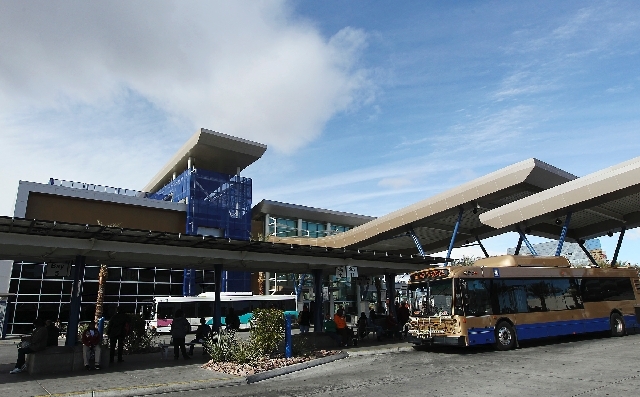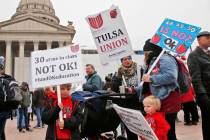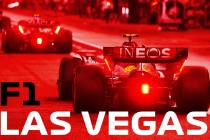Younger generation pushes demand for public transportation
For decades, Tom Skancke has been expounding on visions of transportation systems that he thinks will catapult our city and its economy into the future. He has talked about monorails, light-rail transit, highway infrastructure, you name it, and he’s not done. But the long time local transportation expert and current CEO of the Las Vegas Global Economic Alliance, formerly the Nevada Development Authority, is also relying on “millennials” to get his message out. And in the past couple of years their actions have done plenty of speaking for his cause.
You see, millennials, or those defined as being born in the ’80s and ’90s, have a different view on how to get around their environments. They are technologically fluent; in fact, they are masters of it. And this way of thinking and living has translated into a one-way ticket out of the smoggy industrial age, more specifically a far lesser reliance on automobiles. Just ask Skancke and others who study transportation. They know. They’re listening.
“Young kids today don’t want car insurance. They don’t want to burn fossil fuels. To them the Industrial Revolution was over in the 1990s. We entered the high-tech age and now the digital age, and the age of cars is so 1952 to them,” he said. “Now you have an educated workforce that doesn’t want downtime (in the form of a morning automobile commute) and wants transit. So we have to provide transit to attract them.”
According to automotive marketing research company, CNW Research, adults from the ages of 21 to 34 account for only 27 percent of the new cars sold today. That’s down from 38 percent in 1985. Even more, less than half of prospective drivers in the age group of 19 and younger even have a driver’s license. That’s down from two-thirds of that population in 1998.
Tina Quigley, general manager of the Regional Transportation Commission of Southern Nevada , has another set of statistics. She likes to cite the national consumer group, U.S. PIRG, which recently published a report where those in the age range of 16 to 34 are driving 38 percent fewer miles annually.
“It never would’ve dawned on me that the younger generation is not driving,” Quigley said.
Good examples
Although the RTC and other transportation officials make the most of the local transit system and look for federal dollars to improve it, Skancke points to Phoenix and Salt Lake City as two examples whose models Las Vegas officials may want to study.
In Salt Lake City, in anticipation of the 2002 Winter Olympic Games, the city implemented the TRAX light rail system. Today it connects Salt Lake’s downtown with Sandy, the University of Utah and its health sciences center, West Valley City, South Jordan and the Salt Lake City International Airport. The city’s bus system extends throughout out Salt Lake City area, including the Salt Lake Valley as well.
In Phoenix, the first 20-mile starter line of the Phoenix Metro light rail system opened in 2008. It runs north-south, up and down the city’s downtown central corridor, and branches east and west from there, and will continue to expand beyond its initial implementation. The system has an estimated 43,000 daily ridership. About a fourth of its cost is covered by fares, the rest by tax subsidies . It is considered the 12th busiest light rail system in the nation.
“They said it would never work. But it is a huge success,” Skancke said.
In Las Vegas, Skancke would love to see a light rail system on Maryland Parkway, connecting McCarran International Airport at its south end and the Las Vegas Convention Center to the north.
The notion is not completely out of the question, as the RTC has been gathering public comment and analyzing ways to improve transit along Maryland Parkway, one of the valley’s busier corridors aside from the Strip, touching the University of Nevada, Las Vegas, Boulevard mall and Sunrise Hospital and Medical Center between the airport and convention center. Skancke said putting light rail on that street would show the international visitor how far we’ve come with our transportation mindset in Las Vegas. Local tourism officials have been vocal about traffic congestion between the airport and the Strip and convention center during heavy convention periods.
“When I get off the plane in Washington D.C., Charles de Gaulle Airport (in Paris) or Beijing, I board a transit system. In Las Vegas we put them in a taxi,” he said. “ For us to be globally competitive on the tourism and economic development playing fields we have to have the transportation infrastructure for tourists, businesses and residents.”
Alexander Paz, an assistant professor of civil engineering and head of UNLV’s Transportation Research Center, has lived in Las Vegas since 2008. After spending time in San Francisco without owning a car, his first major purchase in Nevada was an automobile.
But Paz, who is working with the RTC on a study to best estimate the demand for the city’s bus rapid transit system , wasn’t surprised to learn he needed a car in Las Vegas. Before coming to UNLV, he briefly studied the local system to get an understanding of his daily travel patterns. And he learned quickly that being without a car in Las Vegas would be difficult.
“I saw it coming. I knew. Transportation is what I study. It’s what I know,” he added.
Busy buses
But Paz said the local transit system is getting better. Even though he lives in Green Valley and commutes by car to work, he thinks officials are doing a good job of trying to better understand where current ridership lives and where future demands will arise.
“I think we’re heading in the right direction. It’s just that it’s going to take time and resources to get to the point where we see the system being highly used by the community,” he said. “There is a significant need to expand the system, not just routes, but frequency.”
Oddly, Paz added, there are plenty of areas in town that show low ridership levels, which may to lead one to think people don’t want or need to use transit in that area. But he said it’s probably a case of people needing more frequent stops at their specific boarding location that would encourage them to use it.
No one understands Paz’s statements better than Quigley. About 60 million people ride the RTC’s bus rapid transit system annually, a number she’s glad to see increasing again. It was at 54 million in 2010. Since the start of the recession, the system has cut about 220,000 service hours. The agency is working to re-establish some of that service, the general manager said.
The RTC runs the 19th busiest bus system in the U.S., and it boasts some of the busiest routes in the nation as well. The double-deck bus lines, such as the Deuce , which covers the Strip from its South Strip Transfer Terminal near Russell Road and Las Vegas Boulevard north to Ogden Avenue in downtown Las Vegas, sees a monthly ridership of about 27,000 people, while the Strip and Downtown Express, which runs from the Premium Outlet Mall North to the Premium Outlet Mall South, tops 16,000 monthly riders. Those two routes are the only transit routes in the country that actually post a profit, helping to subsidize other costs for the agency’s bus operations, Quigley said.
Other busy routes include the 202, which runs along Flamingo Road west from the Strip all the way to Grand Canyon Parkway. That route sees about 12,000 monthly riders, on par with some light rail systems, Quigley said. The Boulder Highway and Sahara Express routes see 10,000 riders. On the Boulder Highway Express, one of the agency’s newer routes, the line stretches from downtown’s Bonneville Transit Center to Sunset Station in Henderson, nearly all of it running along Boulder Highway. The Sahara Express route also stretches far into the west valley along Sahara Avenue. Both it and the Flamingo route are popular with workers on the Strip , Quigley said.
For a complete list of bus routes, visit: www.rtcsnv.com, click on the “transit” tab, then the “maps, schedules & detours” tab.
The system’s seven Express routes use a dedicated roadway for buses. This allows for faster service, as buses don’t need to compete with automobiles for their portion of the street. Quigley said the RTC is always looking for ways to add more routes, and add greater frequency along busy routes. This summer, the agency is looking to add more frequent stops to the Boulder Highway Express route and others along Tropicana Avenue and Charleston Boulevard to meet increasing demand. The goal is to have buses stopping at stations every 15 minutes during peak times, Quigley explained.
Funding, technology
The RTC is looking to expand routes and improve its infrastructure by pursuing federal grants. Increased capacity along Flamingo Road could be helped by a $12 million federal Transportation Infrastructure Generation Economic Recovery grant, which is being reviewed. Another federal infrastructure grant for $10 million has also been applied for.
“One of the reasons we were so successful in the past with getting money for transfer terminals was because of our congressional delegation. They all worked together to help get us that money,” Quigley added.
Beyond route expansion, the RTC leader said modern buses and a system that uses technology well is a priority. By simply replacing aging buses along certain routes in the past few years, a 15 percent ridership increase was seen. Riders also like being able to access a rider tracking GIS system via a phone application to see where there bus is along a route. Patrons can also purchase tickets from boards at bus stations or online as well.
“We’ve worked hard to improve the public perception of transit,” she said. “One of the most important things we can do for a route is have a great vehicle. Have it new, clean and impressive, that actually conveys to passengers that this is a safe and efficient system.”
The RTC also wants transit centers to be as accommodating as possible and integrate other forms of transportation. Downtown’s Bonneville Transit Center has a bike mechanic on duty, lockers, showers and places to store one’s bike. RTC buses carry about 50,000 bikes a year.
Beyond the bus
Paz and others highlight the importance of a multimodal transit system, not just buses or light rail. In San Francisco, Paz used a car-sharing program, Zipcar, that allowed him to ride his bike to a car lot, use a car for several hours after reserving it online, then come back to his bike to pedal home. Zipcar — and there are other car-sharing programs out there, too — is available in major cities such as Seattle; Washington, D.C.; Pittsburgh; Miami; and Chicago .
Efforts to get a similar system in place in Las Vegas are underway, the most noteworthy of late is Zappos.com founder Tony Hsieh’s Project 100 program. The program is designed to encourage more community engagement by helping people use different modes of transportation.
Project 100 includes on-demand cars with drivers, shared cars, bike-sharing and shuttle buses. The app allows users to input the “zone” they are in and the one they’d like to travel to. The application gives the rider options for how to get there and what types of resources are available. The program also recently signed on 100 Tesla Model S, all electric, vehicles to use in its car-sharing segment. For more information about the program, visit: www.goproject100.com.
The RTC also encourages the city’s employers to engage in its Club Ride program. The effort encourages people to carpool or using alternative methods to get to and from work, like transit, car-sharing or other modalities. Through the RTC website, employees can report their commuting methods to the RTC, which offers them gift cards and other awards.
To help facilitate the program and car-pooling in general, the RTC also has 11 Park & Ride lots around the valley, which allow users to park their cars at a site for free before boarding a bus or connecting with someone else to share a ride. The three busiest Park & Ride centers in the city are in Centennial Hills, the South Strip Transfer Terminal and Summerlin’s Westcliff Transit Center, near the Suncoast. The RTC also recently opened a new Park & Ride center at the Fiesta Henderson. The Club Ride initiative has enrolled nearly 30,000 commuters with 300 employers participating.
Skancke sees car-sharing, a service he himself has used, carpooling and employer programs that encourage transit use as big positives. And the programs’ success highlight, perhaps, that the community as a whole is ready to take the next steps to improve local transit. But he seems more convinced that a new generation of workers are the ones who will force the hand of transportation change in the city.
“You can fund whatever you want. But this takes leadership, courage and some vision,” he said. “We have to create a cultural shift in how we move people and how we think about where our community needs to go.”
And a few more tax dollars might help too.














